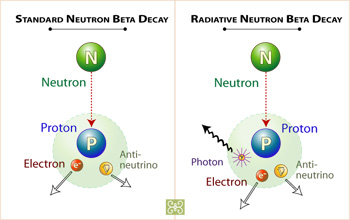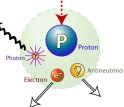News Release 06-177
Researchers Observe Rare Light-emitting Decay of Neutrons
Discovery could pave the way for "new physics"

Rarely, a decaying neutron will produce photons of light (right panel).
December 21, 2006
This material is available primarily for archival purposes. Telephone numbers or other contact information may be out of date; please see current contact information at media contacts.
Neutrons -- the tiny particles that match with protons to form the innards of nearly every atom in the universe -- decay when left to fend for themselves outside an atomic nucleus. For decades, researchers have predicted but never proved that roughly 1 in 1,000 of those decays will produce light in the form of an energetic photon.
Now, for the first time, researchers have caught the photons from that "radiative decay" in action. Reporting in the Dec. 21, 2006, issue of Nature, a team of researchers from the United States and Britain show results that may confirm neutron radiative decay.
In addition to helping to prove a theory, the findings shed light on the intricacies of the so-called "weak force," which, along with gravity, the electromagnetic force and the strong force, form the four fundamental forces of nature.
"This is the first experiment to make a definitive detection of these rare photons," said Fred Wietfeldt, assistant professor of physics at Tulane University. "The next step is to make more precise measurements of their energy, direction and polarization. This opens the door to a new class of experiments to further elucidate the weak force and perhaps find hints of new physics."
While within an atom's nucleus, neutrons and protons are bound together, and only under certain conditions do the neutrons decay. When removed from the atom, neutrons decay rapidly with a half-life of only 10 minutes, each breaking down to produce a proton, an electron and an antineutrino, and rarely, a photon.
With support from the National Science Foundation (NSF) and the National Institute of Standards and Technology (NIST), the physicists set up their experiment to interact with a beam of cold neutrons at the NIST Center for Neutron Research in Gaithersburg, Md.
To observed radiative decay photons, the researchers carefully measured when the various decay products arrived at a detector. If the decay occurs, according to theory, photons and electrons will arrive at the detector 20-millionths of a second ahead of the slower protons. Antineutrinos are too weak to be detected. The study revealed that three out of every 1,000 decays produce photons.
The neutron beam contains a large number of background photons, "which makes the task of identifying the relatively rare radiative decay photons a true 'needle in the haystack' search," added Wietfeldt.
"This result is a very significant achievement," said Bradley D. Keister, program director for nuclear physics in NSF's mathematical and physical sciences directorate. "Radiative neutron decay is an important process to measure because of its rather direct connection to the standard model, but has been difficult due to very high backgrounds."
The research was conducted by physicists at Tulane University, University of Michigan and University of Maryland in collaboration with scientists at the National Institute of Standards and Technology Physics Laboratory and the University of Sussex in the United Kingdom.
-NSF-
-
Three out of every 1,000 neutron decays produce photons of light.
Credit and Larger Version
Media Contacts
Josh Chamot, National Science Foundation, (703) 292-7730, email: jchamot@nsf.gov
Kathryn Hobgood, Tulane University, (504) 865-5229, email: hobgood@tulane.edu
Program Contacts
Brad Keister, National Science Foundation, (703) 292-7377, email: bkeister@nsf.gov
Principal Investigators
Jeffrey Nico, NIST, (301) 975-4663
Fred E. Wietfeldt, Tulane University, (504) 862-3175, email: few@tulane.edu
Related Websites
Tulane University Press Release: http://www2.tulane.edu/article_news_details.cfm?ArticleID=7018
The U.S. National Science Foundation propels the nation forward by advancing fundamental research in all fields of science and engineering. NSF supports research and people by providing facilities, instruments and funding to support their ingenuity and sustain the U.S. as a global leader in research and innovation. With a fiscal year 2023 budget of $9.5 billion, NSF funds reach all 50 states through grants to nearly 2,000 colleges, universities and institutions. Each year, NSF receives more than 40,000 competitive proposals and makes about 11,000 new awards. Those awards include support for cooperative research with industry, Arctic and Antarctic research and operations, and U.S. participation in international scientific efforts.
Connect with us online
NSF website: nsf.gov
NSF News: nsf.gov/news
For News Media: nsf.gov/news/newsroom
Statistics: nsf.gov/statistics/
Awards database: nsf.gov/awardsearch/
Follow us on social
Twitter: twitter.com/NSF
Facebook: facebook.com/US.NSF
Instagram: instagram.com/nsfgov

